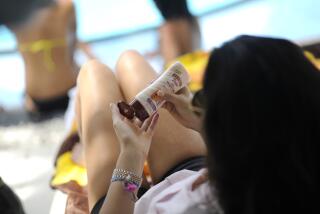The Facts on Skin Cancer--and How to Reduce the Risks
- Share via
Skin cancer is the most common cancer in the United States, with about 800,000 new cases diagnosed every year. When diagnosed early, most skin cancers are easily treated and highly curable. But they can be life-threatening when allowed to progress.
Experts believe that many cases of skin cancer could be prevented with one simple behavioral change--avoiding exposure to the sun. While small amounts of sunshine can be good for you (because sun exposure stimulates your skin to produce vitamin D), getting too much sun significantly increases your risk of skin cancer.
Ultraviolet, or UV, radiation emitted by the sun is thought to be the culprit. The UV radiation penetrates the skin, burns it and damages genes within the skin cells. It is the genetic damage caused by UV radiation that puts you at risk.
Here are a few simple tips to reduce your risk of skin cancer:
* Avoid midday sun exposure. Ultraviolet rays from the sun are strongest and most damaging between 10 a.m. and 3 p.m.
* Wear protective clothing when outside. Long-sleeve shirts and pants offer some protection against the sun. However, not all fabrics offer equal protection. In general, stick to darker, drier and heavier, tightly woven fabrics.
* Hats are helpful, but be aware that significant amounts of reflected light still reach your face.
* When outside, always use a sunscreen on exposed parts of your body. Select a sunscreen that reduces both UVA (ultraviolet A) and UVB (ultraviolet B) rays. (Some available sunscreens block only UVB rays and provide less protection than those that block both.) Apply it liberally and reapply frequently.
* Stay in the shade as much as possible. Because ultraviolet rays from the sun are reflected off surrounding surfaces (particularly light-colored surfaces like sand and snow), they can still reach you, even in the shade. For this reason, protective clothing and sunscreen should still be used.
* Avoid exposure to artificial sources of ultraviolet light, such as sunlamps and tanning booths. The ultraviolet rays generated by these devices are just as harmful as those emanating from the sun.
* Children who suffer severe sunburns during childhood are more likely to develop skin cancer later in life than children who never burned. Sunscreen, however, is not recommended until 6 months of age, so infants should be kept out of the sun as much as possible. After 6 months, sunscreens can be used safely on most children.
* Protect yourself from the sun year-round. Although ultraviolet radiation is most intense in the summer, it is present all year.
* The American Cancer Society recommends that you perform a complete examination of your skin every month. Stand in front of a full-length mirror and look for the following warning signs: any change in the color, size or shape of a mole; sores or lesions that crust, bleed or fail to heal; moles that are particularly large. Don’t overlook the parts of your body that are more difficult to see, like the bottom of your feet and your back. Use a mirror to view these areas, or ask a spouse or friend to examine them for you.
*
Dr. Jonathan Fielding is the director of public health and health officer for the L.A. County Department of Health Services. Dr. Valerie Ulene is a board-certified specialist in preventive medicine practicing in Los Angeles. They can be reached at [email protected]. Our Health runs the second and fourth Mondays of the month.





